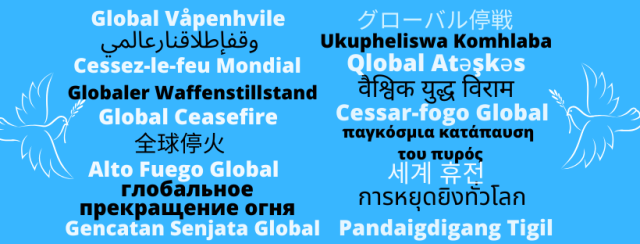 Global Ceasefire supports the UN call for a global ceasefire during the Covid-19 pandemic and beyond. [source: Global Ceasefire on Facebook]
Global Ceasefire supports the UN call for a global ceasefire during the Covid-19 pandemic and beyond. [source: Global Ceasefire on Facebook]
[This is an excerpt from an article in The Round Table: The Commonwealth Journal of International Affairs. Opinions expressed in articles do not reflect the editorial position of the Round Table.]
When the COVID-19 pandemic broke out in March 2020, the UN Secretary General called for a global ceasefire to help respond to the virus, create better conditions for the delivery of life-saving humanitarian aid and open-up space for diplomacy. The logic was compelling: that armed groups should stop fighting each other in order to fight the virus. The organisation I lead, Crisis Action, immediately sprang into action to mobilise support for the global ceasefire. We organised two videoconferences for over 130 international NGOs, coordinated letters to the UN Security Council and the African Union (signed by over 200 organisations from 35 countries), and worked with high-profile individuals from the Pope to Mary Robinson, Ban Ki-moon and a number of foreign ministers to support the ceasefire. A social media campaign to support the #GlobalCeasefire and #Doves4Peace reached over 8.6 million people worldwide. A petition by Avaaz supporting the global ceasefire garnered over 2.2 million signatures. These initiatives secured global, high-profile media coverage from The New York Times to CNN Arabic.
Within weeks of the initial call, 110 countries had supported the ceasefire and 24 warring parties in 11 conflict zones, agreed to put down their arms; this included situations in Cameroon, the Central African Republic, Colombia, Libya, Myanmar, the Philippines, South Sudan, Sudan, Syria, Ukraine and Yemen. This resulted in a temporary de-escalation of violence in some of the world’s most devastating conflicts.
However, many of these temporary truces expired without extensions, resulting in little improvement on the ground. A hopelessly divided UN Security Council refused to even endorse the global ceasefire call for 3 months and when it did finally pass a resolution in July, much of the momentum behind the call had been lost. Fighting began to escalate in major conflicts including Yemen, Libya and Afghanistan. Meanwhile the exact impact of COVID-19 in many war zones was hard to measure given limited testing and data, limited medical facilities and perhaps also younger populations and the existence of other deadly diseases.
As 2020 comes to a close, the UN is brokering talks on ceasefires or peace negotiations in many war zones such as Yemen, Syria and Libya. Perhaps these talks have been helped by the initial global ceasefire call. Perhaps the pandemic has enabled warring sides to have more empathy for each other. Let’s hope so, as the extreme challenges of COVID-19 have added to an already dire humanitarian situation in many conflicts such as Yemen, where 80% of the population is dependent on humanitarian aid. 2021 is looking like the worst humanitarian crisis year in 75 years.
Andrew Hudson is the Executive Director of Crisis Action in New York.



